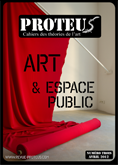L’artiste, la critique et l’espace public
Abstract
 Télécharger l’article
Télécharger l’article
Paru dans : Proteus n°3

L’artiste « politique », polémiste, a eu à cœur dans la modernité de s’inscrire dans l’espace public et de sortir des lieux confinés de l’atelier pour s’offrir une visibilité publique ; geste qui, en soi, possède déjà une portée politique en ce qu’il inaugure un régime de responsabilité de l’artiste face au corps social. Aujourd’hui, la tradition du happening et d’un art diogénique qui affirme haut et fort sa place dans la cité cède plutôt la place à des modes d’insertion et d’immixtion emprunts de discrétion, formes furtives , et qui n’ont rien a priori de politique, au sens où on utilisait le terme il y a encore une trentaine d’années. Si leur valeur tient dans leur capacité à déjouer les codes et formes convenus d’un art contemporain, cible de la critique institutionnelle, celle-ci tient surtout dans le transfert de responsabilité au spectateur qu’elles opèrent, inscrivant ainsi le potentiel critique de l’art dans le champ de l’esthétique et non de la politique.
Mots-clés : art social — esthétique relationnelle — avant-garde — performance — art politique
During modernity period, the « political » artist, polemist, has wished to abandon his own private studio and to establish himself in the public space in order to gain a wider visibility. This bears in itself a political sense in introducing the responsibility of the artist towards society. Nowadays, this tradition is being replaced by forms spanning insertion, discretion and infiltration, which seem to have no political meaning, as it was asserted the last thirty years. Those practices hold their values in escaping from the codes and conventional forms of contemporary art, itself unable to avoid the institutional criticism. Moreover, their interest lies in the fact that they transfer their accomplishment to the audience. In that extent, they inscribe their potential critic in the aesthetic field rather than in the political one.
Keywords : social art — political art — relational aesthetics — avant-garde — performance








